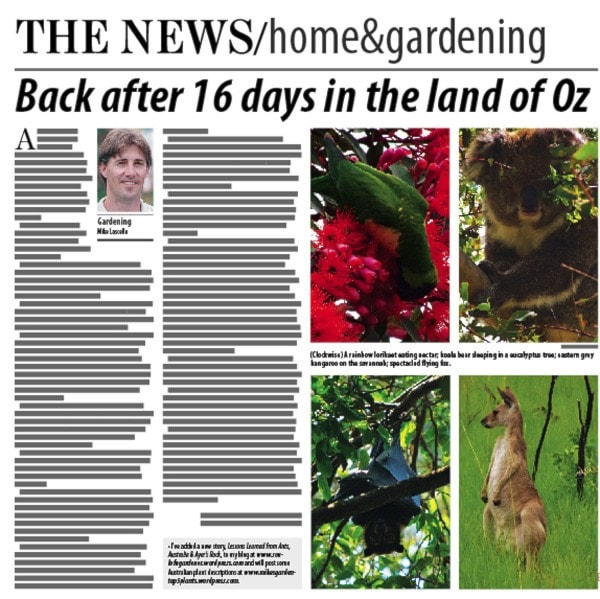Australia, the place where the people are friendly, coffee is called ‘long black’ and everything about driving is backwards (which is why I kept mixing up the turn signal and windshield wipers) – it was also my home for 16 days.
The trip was a gift from my eldest daughter Nicole, a tour to celebrate the old man’s 50th birthday.
We began our adventure on Phillip Island, just off the south coast, starting with a koala sanctuary riddled with kookaburra birds, whose calls resemble a sound track from an old Tarzan movie.
The koalas here are totally dependent on the new growth of seven species of Eucalyptus for food – feeding for just four hours a day and sleeping for the other 20.
Travelling to the west coast, we spent the rest of the day at The Nobbies, two large rock formations that mark the nesting site of the tiny (30 centimetre tall) fairy penguin. We watched the famous penguin parade at sunset, when about 600 waddled ashore and started marching up the often steep slopes back to their burrows and hungry chicks.
It is a bleak landscape covered in little more than pink ice plant (Delosperma) and Bower spinach (Tetragonia implexicoma), which tastes like salted green beans and was used by Captain Cook to prevent scurvy among his crew.
We ended our time here with a boat tour of Seal Rocks, where a healthy population of 8,000 Australian fur seals amazed us with their aquatic aerobatics and sheer numbers.
We then flew into the heart of the desert to visit one of the great natural wonders of the world – Ayer’s Rock, or Uluru – spending several days hiking around the massive red icon (and nearby Kata Tjuta), visiting all the gorges (water holes), ceremonial caves and pictographs.
When outsiders first arrived here, they promptly took control of the area away from the Aborigines – thinking that they did little or nothing to maintain their traditional lands. The result of this debacle was the prompt extinction of 150 species of desert plants.
We traveled northward to Cairns in Queensland in order to catch our dive boat for the Great Barrier Reef. During the next four days on board the MV Taka we did little more than scuba dive four times a day, eat and sleep – but even here the role of plants is essential.
One example was the symbiotic relationship that exists between giant clams (we saw one 1.5 metres across that was about 70 years old) and the algae that grows on them, which produces at least some of their food.
Next we visited the tropical rainforests and savannahs of North Queensland, stopping at a Flying Fox rescue in Kuranda. I was amazed just how intelligent and personable these large bat-like creatures are, with their expressive eyes and almost canine heads. They actually respond to names and enjoy play-fighting with their handlers. These herbivorous mammals eat only fruit and a few local politicians want to eradicate them entirely to protect cultivated crops such as mango – the only problem being that they were here first and are critical pollinators and seed dispersers in the rainforest habitat.
We drove further north into the dry savannahs where the scenery looks like the old west, complete with cowboys, cattle and horses – just add kangaroos, lots of them.
We ended our trip at sunset, in front of a lava tube cave, where hundreds of microbats emerged to feed just inches from our faces, with poisonous snakes in the overhead trees trying to grab one for a snack.
Having been able to visit the temperate south, deserts, tropical rainforest, savannahs and reefs of Australia – I really came to appreciate how it had evolved on an entirely different level than most places. Let’s just hope that the continent where algae feeds giant clams and flying foxes reseed the rainforest can stay just the way it is, a unique and irreplaceable part of this world that we all share.
Mike Lascelle is a local nursery manager and gardening author. Email him at hebe_acer@hotmail.com.
Blog
Mike has a new story on his blog at www.soulofagardener.wordpress.com called Lessons Learned from Ants, Australia & Ayer’s Rock. He will post some Australian plant descriptions at www.mikesgardentop5plants.wordpress.com.
